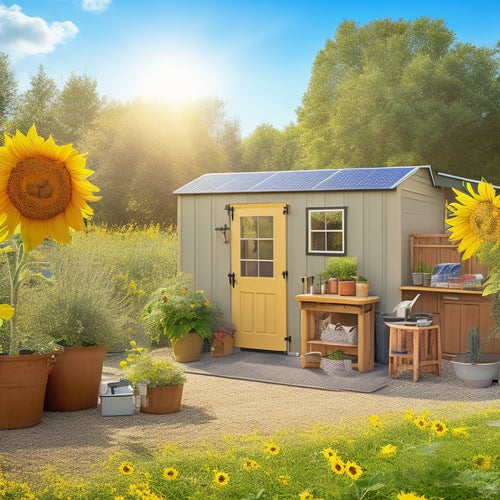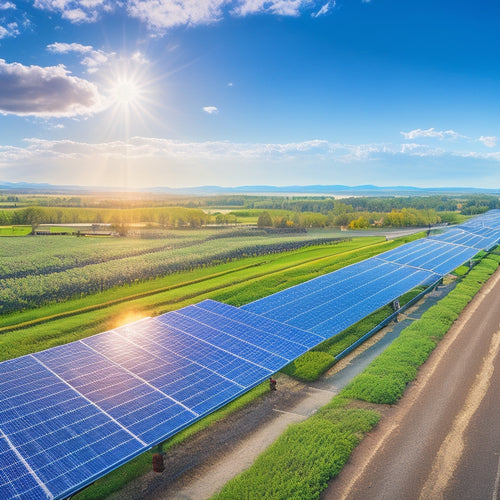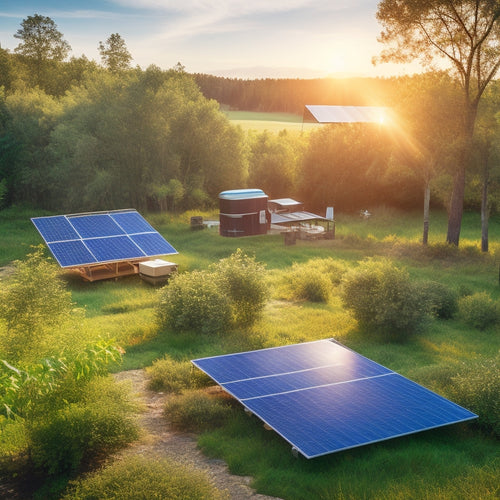
Top Rated Solar Panels for Hiking and Backpacking
Share
When you're hiking or backpacking, top-rated solar panels like the Goal Zero Nomad 20 and Anker 21W are your best companions. They're lightweight and designed for easy packing, so you can charge devices without adding extra weight. Monocrystalline options offer the highest efficiency and durability, essential for keeping your gear powered in outdoor settings. Look for features like USB ports for direct charging and foldable designs for versatile use. Position your panel at the right angle for maximum sunlight capture. Want to know which panels suit your specific needs? There's more to investigate!
At a Glance
- Choose lightweight and portable solar panels like Anker 21W or Goal Zero Nomad 20 for easy transport during hikes.
- Opt for durable materials such as monocrystalline for maximum efficiency and longevity in outdoor conditions.
- Ensure solar panels feature USB ports for direct charging of devices like phones and cameras while on the trail.
- Position solar panels at a 45-degree angle for optimal sun exposure and improved energy output.
- Pair solar panels with high-capacity power banks to store excess energy for later use during extended trips.
Lightweight and Portable Design
When you're hiking or backpacking, the last thing you want is heavy gear burdening you down.
Lightweight and compact solar panels can easily fit into your pack, providing power without the bulk.
You'll appreciate how their portable design allows you to stay charged up while on the move.
Compact Size Advantages
Although you might think that solar panels are bulky and cumbersome, many modern options are designed with a compact size that makes them incredibly lightweight and portable.
Compact solar panels are a revolutionary development for hikers and backpackers who crave freedom and flexibility on their journeys. These panels easily fit into your pack without burdening you, allowing you to focus on the trail ahead.
When you choose compact solar panels as part of your hiking essentials, you're investing in convenience. They can charge your devices quickly, so you can stay connected or capture stunning photos without worrying about battery life.
Plus, their foldable or rollable designs mean you can set them up almost anywhere, whether you're resting at a scenic overlook or camping under the stars.
With the right compact solar solution, you can appreciate the great outdoors without sacrificing power. Imagine enjoying the freedom of the wild while keeping your devices charged and ready.
You'll find that these lightweight options enhance your hiking experience, giving you more time to discover without the constant worry of running out of energy.
Weight Considerations for Portability
Weight is an essential factor to take into account when choosing solar panels for hiking and backpacking, as every ounce counts in your pack. You don't want to compromise on power while lugging around unnecessary weight. When evaluating options, consider the solar panel materials used, as lightweight materials like monocrystalline silicon often offer the best efficiency-to-weight ratio.
Here's a quick durability assessment of popular solar panel types:
| Solar Panel Type | Weight (lbs) | Durability Rating |
|---|---|---|
| Monocrystalline | 2.5 | 9/10 |
| Polycrystalline | 3.0 | 8/10 |
| Thin-Film | 1.8 | 7/10 |
| Flexible Panels | 2.0 | 6/10 |
| Bifacial Panels | 3.5 | 8/10 |
When you're out in the wild, a lightweight and portable design will allow you to navigate with ease. Choose a solar panel that balances weight and durability, giving you the freedom to roam without feeling weighed down. After all, the beauty of nature awaits, and you don't want to miss it!
Reliable Power on the Go
When you're out hiking or backpacking, having a reliable power source can make all the difference.
Lightweight and portable solar panels offer efficient charging solutions, ensuring your devices stay powered throughout your journey.
These devices not only eliminate dependence on traditional outlets but also allow you to convert sunlight into electrical energy while you traverse the great outdoors.
You'll appreciate the convenience of utilizing the sun's energy while you traverse the great outdoors.
Lightweight and Portable Options
As you embark on the great outdoors, having a dependable power source can greatly improve your hiking or backpacking experience. Lightweight and portable solar panels offer the ideal solution for keeping your devices charged without burdening you.
Today's solar panel types are designed to be compact, so you can easily slip them into your backpack. When selecting a solar panel, look for options that fold up or roll up, making storage and transport a breeze.
These panels are often equipped with USB ports, enabling you to charge devices like your phone, GPS, or camera directly from the sun's energy. This means you can stay connected or capture those breathtaking views without worrying about battery life.
Many of these portable panels also come with built-in clips or loops, allowing you to attach them to your pack or tent for ideal sun exposure while you hike.
Whether you're planning a short day trip or a longer backpacking journey, investing in a lightweight solar panel guarantees you have the dependable power you need to welcome your freedom in the wild.
Efficient Charging Solutions
Utilizing the sun's energy efficiently can revolutionize your hiking and backpacking journeys. With the right solar panel types and charging accessories, you'll never have to worry about running out of power again. Imagine trekking through stunning scenery while your devices charge effortlessly.
Here's a quick comparison of popular solar panel types and their compatible charging accessories:
| Solar Panel Type | Best Charging Accessories |
|---|---|
| Monocrystalline Panels | Power banks, USB chargers |
| Polycrystalline Panels | Battery packs, car chargers |
| Thin-Film Panels | Solar backpacks, portable batteries |
| Foldable Solar Panels | Multi-device chargers |
| Flexible Solar Panels | Clip-on chargers, power banks |
When choosing your solar panel, consider portability and efficiency. Monocrystalline panels often offer the highest efficiency, while foldable options are perfect for those who want lightweight solutions. Pair these with reliable charging accessories, and you'll guarantee your devices stay powered, allowing you to welcome the freedom of the great outdoors. With efficient charging solutions, you can focus on the journey instead of worrying about battery life. Happy trails!
Key Specifications and Benefits
When choosing a solar panel for your hiking and backpacking trips, efficiency and power output are essential factors to take into account.
High-efficiency monocrystalline solar panels are particularly recommended for their superior energy output, ensuring you can keep your devices charged without burdening you.
You'll want a panel that packs enough punch to keep your devices charged without encumbering you.
Portability and lightweight designs can make all the difference, ensuring you stay mobile while enjoying the great outdoors.
Additionally, evaluating your energy needs is critical for selecting the appropriate battery capacity and type to complement your solar setup, as highlighted in off-grid energy solutions.
Efficiency and Power Output
Efficiency and power output are essential factors to reflect on when choosing solar panels for hiking and backpacking. The right solar panel materials can make a significant difference in how much energy you gather on your outdoor excursions.
Look for panels made from high-efficiency monocrystalline silicon, as they often deliver the best performance in limited sunlight.
You'll also want to assess the charging speed of your solar panels. Faster charging means you can get back to your journey sooner, so choose models that can quickly convert sunlight into usable power.
Many portable options now offer integrated features like USB ports, making it easy to charge devices on the go.
When evaluating efficiency, check the panel's wattage output and how it aligns with your power needs. A higher wattage translates to more energy, allowing you to keep multiple devices charged simultaneously.
Ultimately, by prioritizing efficiency and power output, you're not just investing in solar panels; you're investing in the freedom to roam without the worry of running out of power.
Enjoy the great outdoors knowing you've got reliable energy at your fingertips!
Portability and Weight Considerations
Choosing the right solar panel for hiking and backpacking means paying close attention to portability and weight. You want a lightweight solution that won't weigh down your pack. Look for solar panels made from durable materials like monocrystalline or polycrystalline, which offer a good balance between efficiency and weight.
Here's a quick comparison of popular options:
| Solar Panel Model | Weight (lbs) | Materials Used |
|---|---|---|
| SunPower 100W | 4.5 | Monocrystalline |
| Renogy 50W | 3.5 | Polycrystalline |
| Goal Zero Nomad 20 | 1.5 | Monocrystalline |
| Anker 21W | 1.3 | Solar fabric |
| BigBlue 28W | 1.5 | Monocrystalline |
When considering durability factors, make sure your solar panel can withstand the elements. Look for features like water resistance and reinforced edges. A lightweight, durable solar panel will not only enhance your escapades but also provide the freedom to keep your devices charged, no matter where your expedition takes you. Choose wisely, and enjoy the open trails!
Selecting Based on Battery Capacity
When choosing a solar panel for your hiking or backpacking trip, understanding battery capacity is vital.
It's important to take into account the energy density and lifespan of the batteries, as high energy density options can maximize your available power in a compact form.
You need to assess your power needs to guarantee you've got enough juice for your devices.
Let's break down how to find the right balance between battery capacity and your energy requirements.
Understanding Battery Capacity
Understanding battery capacity is vital for anyone looking to power their hiking and backpacking expeditions with solar panels. It's not just about having a solar panel; it's about knowing how long you can rely on it to keep your devices charged.
Different battery types—like lithium-ion, lead-acid, or nickel-metal hydride—offer varying capacities and weights, impacting your pack's overall comfort.
When you're out on the trail, you want to maximize your freedom. This means choosing batteries that can hold enough power to meet your needs without adding unnecessary weight.
Pay attention to charging times, too; some batteries recharge faster than others, which can make a significant difference in the field.
A higher capacity battery will store more energy, allowing you to power devices like GPS units or smartphones for longer periods.
However, remember that higher capacity often means a heavier battery, so it's important to strike the right balance.
Assessing Power Needs
Before you hit the trail, it's crucial to figure out your power needs based on the devices you plan to use. Start by making a list of all your gadgets—think smartphones, GPS devices, cameras, and any other electronics you can't do without. Each device has a specific power consumption rate, usually measured in watt-hours (Wh). Knowing this will help you calculate how much energy you'll need.
Next, consider the duration of your trip. Will you be out for a weekend or longer? Multiply the power consumption of each device by the number of hours you'll use them daily, and sum that up for the entire trip. This gives you a clear representation of your total energy needs.
Now, let's talk battery capacity. You want a solar panel and battery system that can comfortably meet or exceed your calculated needs. A good rule of thumb is to aim for a battery that offers at least 20% more capacity than your total energy requirements, giving you some breathing room in your energy management.
With the right setup, you'll enjoy the freedom of staying connected, no matter where your journeys take you.
Higher Efficiency in Sunlight
When you're out in the wild, making the most of sunlight is key to keeping your devices charged.
Understanding how to maximize solar output can dramatically improve your hiking experience and guarantee you stay connected.
Let's investigate some effective strategies to increase your solar panel's efficiency under the sun.
Maximizing Solar Output
Maximizing solar output is essential for powering your devices on the trail, especially when you're relying on limited sunlight. To get the most from your solar panel technology, position your panels at the ideal angle towards the sun. Generally, that means tilting them at about 45 degrees during midday when the sun is highest.
Remember, even slight adjustments can greatly enhance energy capture.
Also, look for panels with higher efficiency ratings. The latest solar panel technology often features monocrystalline cells, which offer better performance in low-light conditions. When you're out exploring, that can make all the difference.
Don't forget about energy storage! Pair your solar panels with a reliable power bank or battery pack. This way, you can store excess energy generated during peak sunlight hours for later use, ensuring your devices stay charged even when the sun dips below the horizon.
Lastly, keep your panels clean and free from debris. Dust and dirt can diminish output, so a quick wipe-down can help maximize that energy conversion.
Adopt these tips, and you'll enjoy the freedom of staying powered up on your journeys.
Frequently Asked Questions
How Do I Maintain My Solar Panels During a Hike?
To maintain your solar panels during a hike, regularly clean them to enhance charging efficiency. Wipe away dirt and debris, ensuring peak performance. Keeping them clear lets you enjoy your freedom without worrying about power.
Can Solar Panels Charge Multiple Devices Simultaneously?
Imagine a busy marketplace, where solar panels serve as merchants, efficiently charging multiple devices like phones and tablets. Their charging efficiency depends on device compatibility, letting you utilize the sun's power and enjoy your freedom on-the-go.
What Weather Conditions Affect Solar Panel Performance?
Weather conditions greatly impact solar efficiency. Cloud cover reduces sunlight, while extreme temperatures can hinder performance. You'll notice diminished output on hot days, so consider these factors when planning your solar setup for best results.
Are Solar Panels Waterproof or Water-Resistant?
When you think of a duck gliding effortlessly through water, consider solar panels. Most aren't fully waterproof but have water-resistant ratings. Their durability keeps them safe in rain, as long as you handle them carefully.
How Long Do Solar Panels Typically Last in the Field?
Solar panel longevity typically ranges from 25 to 30 years. In the field, their performance can vary based on conditions, but with proper care, you'll enjoy reliable energy for your journeys over many years.
Explore More
As you gear up for your next journey, imagine the thrill of staying powered up even in the wildest terrains. With the right lightweight solar panels, you won't just be hiking; you'll be exploring without limits. Visualize yourself charging your devices while soaking in breathtaking views, completely off the grid. Don't leave your tech behind—choose a solar panel that fits your needs, and welcome the freedom of power on the go. Excitement awaits!
Related Posts
-

Building an Emergency Backup Solar Power System in 5 Essential Steps
Building an emergency backup solar power system involves five key steps. First, assess your daily energy needs to ide...
-

Applications of Photovoltaic Systems
Photovoltaic systems are versatile, converting sunlight into electricity for various applications. You can use them i...
-

Top Off Grid Solar Batteries for Renewable Energy
When seeking top off-grid solar batteries for renewable energy, consider options with advanced battery chemistry, suc...


